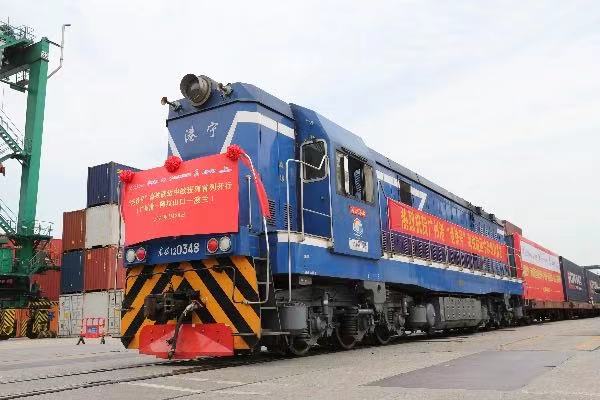China-Europe freight train cargo value exceeds 14 billion yuan in Guangzhou over past five years
The cargo value of China-Europe freight trains riding the rails after setting off from Dalang railway station in Guangzhou, capital of south China’s Guangdong province, surpassed 14 billion yuan (about $2.17 billion) since the city launched its first cargo train to Vorsino in Russia in 2016.

A China-Europe freight train leaves Guangzhou, Guangdong province. (Photo/gz.gov.cn)
The freight trains departing from the city, which has traditionally depended more on maritime freight services, have made 387 trips altogether while transporting 35,932 twenty-foot equivalent unit (TEU) containers of goods over the past five years.
The city’s China-Europe freight trains have delivered a variety of cargo, including communications equipment, home appliances, lamps and lanterns, and furniture from the Guangdong-Hong Kong-Macao Greater Bay Area, one of the most important manufacturing bases in the world.
“China-Europe freight trains offer us a new option to export our products to Europe, and rail freight is faster than sea freight and more cost-effective than air freight,” said Chen Huanru, manager of the logistics department of Guangdong Midea Kitchen Electrical Appliance Manufacture Co., Ltd.
As of Aug. 27, 85 freight trains loaded with 8,498 TEUs and with a cargo value of more than 2.62 billion yuan, had left the Dalang railway station for Europe this year, up 54.55 percent, 67.15 percent, and 43.39 percent year-on-year, respectively.
In addition to the advantages of the freight trains, streamlined customs clearance has also facilitated two-way trade between China and Europe. Guangzhou Customs has set up special service windows to offer one-stop services for the freight trains and has streamlined declaration procedures. As a result, it only takes 15 days on average for the freight trains to arrive at their destinations in Europe, over 15 days shorter than sea shipping routes.
- China's manufacturing powerhouse sees foreign trade growth in Q1
- First JSQ freight train from NE China's Heilongjiang to Europe departs
- China-Europe freight trains hit record high in Guangdong
- Key customs in China's Guangdong report surge in int'l freight trains between Jan.-Feb.
- Economic Watch: Foreign companies optimistic about Chinese market

